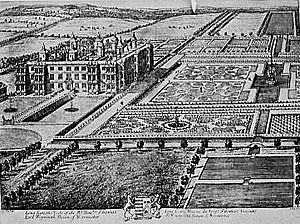Thomas Thynne (died 1639) facts for kids
Sir Thomas Thynne lived a long time ago, from about 1578 to 1639. He owned a lot of land in England, especially at a place called Longleat in Wiltshire. He was also a politician, meaning he helped make laws in the English Parliament, called the House of Commons. He served there many times between 1601 and 1629. What's really interesting is that his love story might have given Shakespeare the idea for his famous play, Romeo and Juliet!
Contents
Sir Thomas Thynne's Early Life and Family
Thomas was the son of Sir John Thynne, who also lived at Longleat. His mother was Joan Hayward, whose father, Sir Rowland Hayward, was once the Lord Mayor of London.
A Secret Marriage and a Famous Play
When Thomas was about 16 years old, in May 1594, he secretly married Maria Touchet. She was also 16 and worked at the court of Queen Elizabeth. Thomas and Maria got married the very first day they met!
They kept their marriage a secret for a while. This was because their fathers, the Thynne family and Lord Audley's family, were big enemies. Their families had been feuding for a long time. When their secret marriage became known, Thomas's parents, especially his mother Joan, tried to cancel it. But they couldn't.
Many people think this secret marriage between feuding families gave Shakespeare the idea for Romeo and Juliet. He wrote the play around the next year, based on an older Italian story.
Thomas and Maria had three sons. Sadly, Maria passed away when their third son was born. Two of their sons, James Thynne and Sir Thomas Thynne, grew up. Thomas's mother, Joan, never truly forgave him for his marriage to Maria. She even took him to court over it.
Maria's Letters and Thomas's Second Marriage
Maria's letters, written between 1595 and 1611, were later published in a book. After Maria passed away in 1611, Thomas married again. His second wife was Catherine Howard. She was related to important noble families. Thomas and Catherine had more sons, including Sir Henry Frederick Thynne, who later became the ancestor of the Marquesses of Bath.
Sir Thomas Thynne's Political Career
Sir Thomas Thynne was involved in politics for many years.
Serving in Parliament
In 1601, he was chosen to be a Member of Parliament for a place called Hindon. He was chosen again for Hindon in 1604. That same year, his father passed away, and Thomas inherited the family estates. He then tried to become an MP for the whole county of Wiltshire. However, the Parliament said he couldn't do that because he was already an MP for Hindon.
Thomas also served as the High Sheriff of Wiltshire from 1607 to 1608. This was an important job, like being the chief law enforcement officer for the county.
He continued his political career, being elected MP for Heytesbury in 1621 and again in 1624. He was then elected MP for Hindon once more in 1625, and again in 1626 and 1628.
Building a New Home
Among the lands Thomas inherited was an estate in Kempsford, Gloucestershire. There, he decided to build a brand new country house. To do this, he had to take down an old, strong manor house that had been there since the 1200s. This old house had protected a crossing point on the River Thames.
Sir Thomas Thynne passed away on August 1, 1639.


